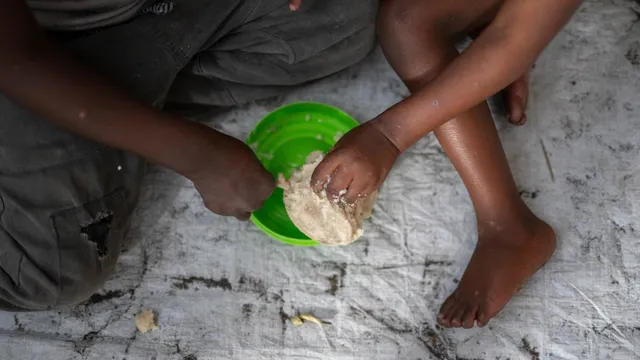
UNICEF reveals systemic sexual violence against children in eastern Congo
2025-04-11 16:07- Thousands of children have faced sexual violence during a two-month period amidst escalating conflict in eastern Congo.
- UNICEF warns of significant funding gaps threatening care for hundreds of thousands of affected children.
- The crisis represents a systemic failure to protect children from ongoing violence and highlights urgent humanitarian needs.
Express your sentiment!
Insights
In eastern Congo, thousands of children have been victims of rape and sexual violence over the span of two months, as reported by UNICEF. This alarming situation coincided with a resurgence of conflict in the region, particularly after the M23 rebels intensified their offensive beginning in January 2025. Government forces and these rebels have been fighting over control of strategic areas in eastern Congo, including major urban centers such as Goma and Bukavu. The conflict has deeply impacted the lives of children, with their vulnerability to sexual violence escalating significantly during this period. According to UNICEF spokesperson James Elder, children represent a substantial percentage of the nearly 10,000 reported cases of sexual violence during January and February. Specifically, it is estimated that children make up between 35% to 45% of these cases. UNICEF's reports highlighted the grave reality of the situation, stating a shocking statistic that indicates a child is raped approximately every half hour. This continuous wave of violence has created a humanitarian crisis, leaving numerous young children without protection or necessary care. Elder expressed concerns regarding the significant funding gaps that UNICEF faces, which threaten essential support for children caught in gender-based violence in armed conflict. Without sufficient financial resources, nearly 250,000 children are at risk of missing out on crucial services that can provide protection and assistance against such violence. The current situation is precarious, with Elder emphasizing that UNICEF has a limited time frame of just 12 weeks to address these issues before the impact of funding shortages is fully realized. The ongoing conflict in eastern Congo, which has already displaced over 7 million people and resulted in an estimated 3,000 deaths, is driven by numerous armed groups, including M23. This group is one of approximately 100 armed factions operating in the mineral-rich territory of eastern Congo, where they exploit ongoing instability for their gain. This systemic violence not only illuminates the depths of human suffering but also underscores the urgent need for international attention and proactive intervention to protect the most vulnerable members of society, particularly children, in the eastern Congo region.
Contexts
The conflict in eastern Congo, particularly in the provinces of North Kivu, South Kivu, and Ituri, has its roots in a complex interplay of historical, social, and political factors. The backdrop of this conflict dates back to the Rwandan genocide in 1994, which led to a surge of Hutu refugees into eastern Congo, exacerbating ethnic tensions and disrupting the existing power dynamics. This influx catalyzed a struggle among various local and foreign armed groups for control over mineral-rich territories. The Congo itself was a centerpiece of exploitation during the colonial era, which fostered a legacy of violence and institutional weakness that persists today. The collapse of Mobutu Sese Seko's regime in the late 1990s only intensified these struggles, as competing factions vied for dominance in the absence of a strong central government. The First Congo War (1996-1997) and the subsequent Second Congo War (1998-2003) marked critical turning points in the region's history, with various foreign armies intervening under the guise of protecting their interests. These wars led to the death and displacement of millions, fundamentally altering demographics and social structures while giving rise to an array of armed groups, including the Mai-Mai militias and the Democratic Forces for the Liberation of Congo (FDLR), each with distinct motivations and allegiances. Despite the official end of the wars, violence has continued, fueled by ongoing conflict over natural resources such as gold, coltan, and diamonds, which are often mined through forced labor and human rights abuses. Humanitarian consequences have been catastrophic, contributing to one of the worst crises in modern history. Over five million people have died as a result of the conflict, and millions more remain internally displaced or seek refuge in neighboring countries. The health infrastructure is severely compromised, as malnutrition, disease outbreaks, and lack of access to basic medical services plague the region. Moreover, widespread sexual violence has become a weapon of war, devastating communities and perpetuating cycles of trauma. Efforts to stabilize the region have been complicated by the persistence of local grievances, weak governance, and ongoing economic exploitation by both local elites and international corporations. In recent years, international initiatives have aimed to address these complexities, focusing on peacebuilding, governance reforms, and economic development. The United Nations Organization Stabilization Mission in the Democratic Republic of the Congo (MONUSCO) has been deployed to provide security and support humanitarian efforts; however, the effectiveness of these initiatives has often been challenged by a lack of cooperation from local authorities and recurring violence from armed groups. The path to lasting peace in eastern Congo is tightly linked to addressing the underlying issues of resource management, military influence on politics, and the need for effective governance that puts the welfare of the Congolese people at its core. Only through sustained engagement, both domestically and internationally, can there be hope for a resolution to the ongoing conflict and suffering in this beleaguered region.